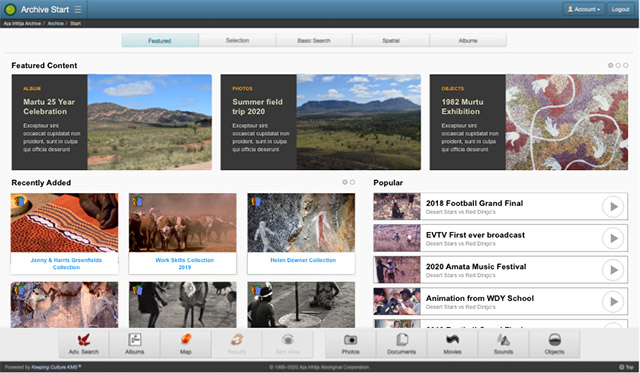Development roadmap: 2021/22
Published: 15 July 2021
Published: 15 July 2021
Keeping Culture is currently planning and working on several small improvements to the software in the next 12 months.
These improvements include (in no particular priority):
WebRTC annotation recording – Completed October 2021
Replace previous movie and audio annotation recording implementation with WebRTC.
SAML-based Single Sign On (SSO) authentication and other user account improvements – Completed December 2022
Introduce Single Sign On archive login functionality to allow authentication from an external identity provider. This will involve overhauling the current User Account system with enhancements to how user accounts are administered.
New ‘Featured’ layout to display curated searches – Completed July 2022. See Cards.
The intention here is to create a mechanism that leads users to specific content of interest within the archive. Whether it be new content, or a group of records that commemorate a community event, the idea is to provide dynamic evolving entry points for users to explore the contents of the archive.
Administrators will create ‘saved’ queries from searches that they have undertaken in the archive. A title, description, thumbnail image and other properties are paired with the saved query to form a ‘curated search’. Curated searches are displayed as graphical ‘cards’ within categories – new, popular, features, etc – in the Featured layout on the Archive Start page.
Viewing a curated search takes the user to the Item View page displaying the records retrieved by the saved search query.

Having a flexible platform to create new functionality was one of the biggest motivations for developing the new system in late 2017. Equally inspiring are our customer’s ideas for the software and the exciting opportunities that are emerging in the Cloud computing space. So the question has to be asked, “Where to from here?”.
Below are some big concepts, grand visions and wild ideas for Keeping Culture’s future:
Dictionary: a multi-lingual dictionary tool for the recording and preservation of language. The dictionary functionality would be integrated with, and supplement, the existing software functionality.
Artificial Intelligence (AI) Cloud services: integrate image analysis to provide object and scene detection, facial recognition and face comparison using Amazon Rekognition. Further opportunities exist to leverage speech-to-text and other language based AI services.
Contributor framework: A framework that analyses an archive’s content in relation to a specific user, in order to determine the user’s authority on, or interest in, a specific subject matter. The analysis would take into account a user’s family, professional and friend networks, country, place, time and metadata contributions to determine which archive content is relevant to them; thus providing a ‘me and my world’ centric experience.
A suite of pages, tools and functionality would be developed to prompt users to contribute information, manage their own contributions (including ingested media), and explore their world via a social media inspired interaction. The more a user contributes to the archive, the larger their ‘me and my world’ experience grows.
Viewing derived relationships: A process whereby record relationships are traversed in order to locate derived relationships that exist in indirectly linked records. For example, when a person’s record is viewed, the system would display derived information such as:
the timeline of places visited and event participated in,
relationships to extended family members,
organisations they have been involved in,
annotations they have made,
archive items they may have created,
archive items they may appear in,
and so on.
Archive Nodes framework: Through a taxonomy approach to structure large and diverse collections of media and knowledge, while allowing community groups to access, manage and contribute to only a subsection of the larger structure. This high-level multi-archive management framework allows any number of archives to hang off a tree-like node structure; where content is shared and accessed based on the position in which an archive sits within the node structure.